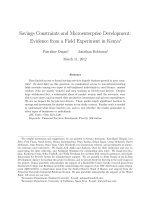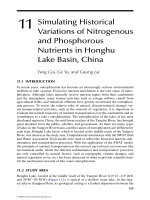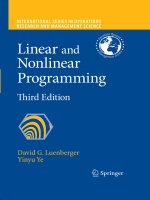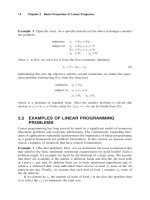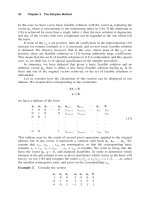ch 11 resource constraints and linear programming
Bạn đang xem bản rút gọn của tài liệu. Xem và tải ngay bản đầy đủ của tài liệu tại đây (293.24 KB, 15 trang )
Ch 11 Resource Constraints
and Linear Programming
The process of finding an optimum
outcome from a set of constrained
resources, where the objective function
and the constraints can be expressed as
linear equations.
Drawing the Linear Model
Standard Graph
0
500
1000
1500
2000
2500
0 500 1000 1500 2000 2500
Number of X units
Number of Y units
Adding the Linear Constraints
Standard Graph: Constraints Added
0
500
1000
1500
2000
2500
0 500 1000 1500 2000 2500
Number of X units
Number of Y units
Constraint 1
Constraint 2
Constraint 3
Feasible
Region
Adding the Iso-Contribution Line
The iso-contribution line is a ‘slope’ which represents the objective
function. It is drawn as a generic line, then ‘floated’ to an optimum
location within the feasible region.
Partial Graph: Notional Iso-Contribution
Line, and Constraints.
0
500
1000
1500
2000
2500
0 500 1000 1500 2000 2500
Number of X units
Number of Y units
Constraint 1
Constraint 2
Constraint 3
Iso
Contribution
Line
Finding the Optimum Point
Float the iso-contribution line to an optimum position.
Finished Graph:
Optimum Iso-Contribution Line Floated
Into Postion Against the Binding
Constraints.
0
500
1000
1500
2000
2500
0 500 1000 1500 2000 2500
Number of X units
N u m b er o f Y
u n its
Constraint 1
Constraint 2
Constraint 3
Iso Contribution
Line
Optimum Iso
Contribution Line
Optimum point.
Algebraic Solution to an Example
LP Problem
Define the objective function:
Z = 0.75 X + 1.82 Y
Set up the resource constraints :
32X + 59 Y <= 4312
200X + 15Y <= 1819
Set up any other limit constraints; e.g;
X >= 0
Y >= 0
X <= 19
Solving the Algebraic Problem 1
In this simple case, the set of algebraic
equations can be easily solved by substitution.
As the Simplex method is tedious, and prone
to error, the solution is best found with
computer software such as Excel Solver.
The standard Excel spreadsheet needs to be
specially adapted to run Solver.
In a more complex case, the Simplex method
can be manually applied.
Solving the Algebraic Problem 2
Additions to the standard spreadsheet are:
An ‘Activity Level’ row for output levels.
A ‘Resource Supply’ column for level of supply of
constrained resources.
A ‘Resource Use’ column for amount of each
constrained resource used, and final objective
function value.
A ‘Sign’ column for the inequality signs:- ( for
information only; not for “Solver” solution.)
Solving the Algebraic Problem 3: The
Adjusted Spreadsheet
Spreadsheet ready for solution.
Solving the Algebraic Problem 4:
Using Excel Solver
Inputs to the Solver dialog box.
Solving the Algebraic Problem 5:
Reading the Solver Results
Read the results from the Solved spreadsheet.
Solving the Algebraic Problem 6:
Reading the Solver Reports (a).
The answer report shows the solution.
Solving the Algebraic Problem 6:
Reading the Solver Reports (b).
The sensitivity report shows possible adjustments to the
solution.
Solving the Algebraic Problem 6:
Reading the Solver Reports (c).
The limits report shows the amount of movement
allowed in the cell values within the constraint levels.
Linear Programming: Summary
Use when an optimum solution is required,
from constrained resources.
Express the objective function and the
constraints as linear equations.
Solve using either the graphical method, or a
computerized model.
Interpret the results.
Consider the sensitivity of the results.
Make a decision.
THE END
